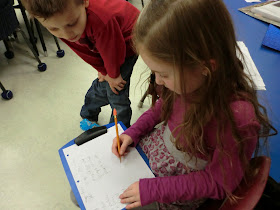The purpose of this blog has always been to allow parents into the world of their children as students, learning new concepts, practising, making mistakes and then finally, after much hard work, being successful. Sometimes it takes a great long time to understand the value of new ideas.

The best way to learn is to be able to hinge our thoughts and ideas onto a real life experience. In teacher talk, that is called scaffolding. The students in Grade two are just beginning to work specifically on the concept of place value for numbers. I decided that a real life application would be to count groups of objects that are really large. We read a story about the Masloppy Family who took inventory of various collections of items in their home. We have been taking inventory of items in our class. On the first day, pairs of students counted bins of books. As I watched and listened I finally heard a child count by 2's and not singly. It was then that I called a math congress. Basically that is an opportunity for all students to share their ideas in a safe way within the class, knowing that their ideas are valued and helpful to others.
Once we discussed why counting by 2's worked better than counting by 1's (the smart child told us it was much faster!), I encouraged the students to choose other groups to count by. The group today that was counting keys, decided to count by 2's until 100, then they went onto create another group of 100 and so on. Here they are using pen and paper to record their ideas. That's the other thing that is different than when you (parents) went to school. The teacher doesn't immediately tell you the best way to do something. The students discover through some trial and error and then through sharing during the math congress, what ways work best for them, or which may be more efficient.
These girls decided originally to count the centicubes by 5's but when they saw how many groups they were getting, they changed their strategy and moved 2 groups of 5 together so they would have groups of 10. They were making decisions based on their needs in the situations...that's becoming real problem solvers!
It was also interesting to hear one girl share that when she was making groups of 5, she looked for groups of 2 and groups of 3 to put together (rather than counting individually up to 5). She is demonstrating her understanding of composing (putting together) numbers!
Finally, another girl shared that she and her partner chose different groups to count by depending on how many items were in the container they were going to count. If the amount seemed small, they counted by 2's, but if the amount was larger, they grouped by 5's and when they thought the amount would be very large, they then used groups of 10's. Math is about making sense of the world around you. Listen to how your child is thinking BEFORE telling them how you would solve the problem!




No comments:
Post a Comment